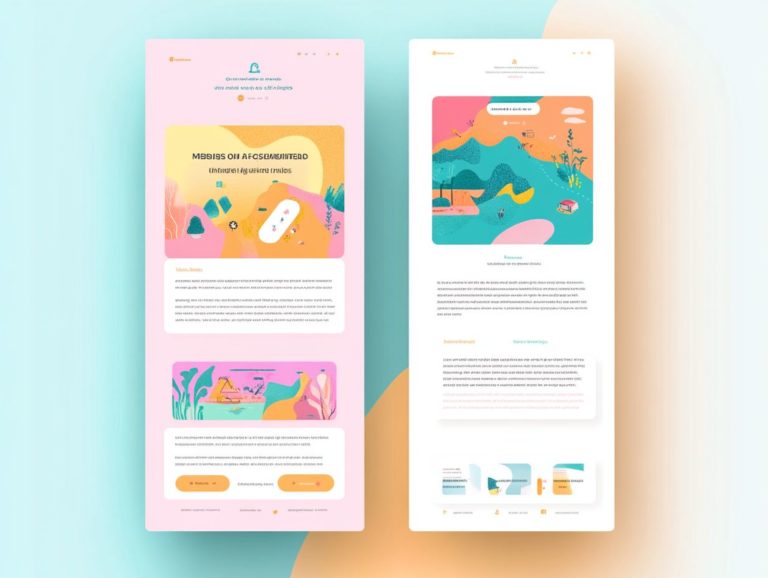Maximize Sales: 10 Key Conversion Optimization Tips
In today s fast-paced digital landscape, converting visitors into customers is essential for your business’s success. This article delves into ten crucial tips for optimizing your website and elevating your conversion rates. Get ready to transform your online presence today!
From gaining a deep understanding of your target audience to streamlining the checkout process, each strategy is crafted to enhance user experience and drive sales. You’ll also explore the significance of consumer behavior, identify common pitfalls to avoid, and discover ways to continuously refine your conversion efforts.
Contents
- Key Takeaways:
- 1. Understand Your Target Audience
- 2. Optimize Your Website’s Design and Layout
- 3. Use High-Quality Visuals and Graphics
- 4. Create Compelling and Relevant Content
- 5. Utilize Call-to-Action Buttons
- 6. Implement A/B Testing
- 7. Simplify the Checkout Process
- 8. Offer Various Payment Options
- 9. Provide Excellent Customer Service
- 10. Utilize Social Proof
- What Is Conversion Optimization and Why Is It Important?
- How Can Understanding Consumer Behavior Help with Conversion Optimization?
- What Are the Different Types of Conversion Optimization?
- How Can a Business Measure the Success of Their Conversion Optimization Efforts?
- What Are the Common Mistakes to Avoid in Conversion Optimization?
- How Can a Business Continuously Improve Their Conversion Rates?
- Frequently Asked Questions
- What is the importance of conversion optimization in maximizing sales?
- What are the top 10 key tips for maximizing sales through conversion optimization?
- How can understanding my target audience improve my conversion rates?
- What is A/B testing and how can it help maximize sales through conversion optimization?
- Can offering special promotions and discounts help with conversion optimization?
- Why is it important to continuously analyze and improve conversion strategies?
Key Takeaways:

- Understand your target audience to tailor your website design and content to their needs and preferences.
- Optimize your website’s design and layout for a user-friendly and visually appealing experience.
- Use high-quality visuals and graphics to capture and maintain the attention of potential customers.
1. Understand Your Target Audience
Understanding your target audience is crucial for digital marketing and directly influences your online business’s conversion rate. By analyzing user behavior and creating detailed user personas, you can tailor your strategies to meet the specific needs and preferences of your potential customers.
Leveraging visitor data and gathering customer feedback will enhance your ability to connect with your audience, ultimately refining your sales copy and value proposition. You’ll discover new ways to connect with your audience!
By delving deeper into these personas, you can ensure that your content resonates on a personal level. Techniques such as surveys, focus groups, and social media listening provide invaluable insights into customer pain points and preferences.
These insights can guide various elements of your digital marketing strategies, from crafting compelling email campaigns to optimizing landing pages. Understanding visitor journeys allows you to pinpoint friction points within the conversion funnel, enabling you to make data-driven adjustments that enhance the overall user experience and drive more conversions.
2. Optimize Your Website’s Design and Layout
Optimizing your website’s design and layout is essential for enhancing user experience and ensuring seamless navigation, which can significantly boost your conversion rate. A well-structured website with intuitive navigation not only attracts visitors but also keeps them engaged, encouraging exploration of your offerings and leading to improved conversions.
A coherent layout helps guide users through their journey, making essential information easily accessible. To refine this approach further, consider using heatmap tools. These invaluable resources provide insights into user engagement and behavior across various sections of your site. By identifying areas where visitors linger or where they drop off, you can make informed adjustments to optimize both layout and content.
In today s mobile-centric landscape, ensuring mobile optimization is imperative. This caters to diverse traffic sources and significantly enhances user engagement across all devices.
3. Use High-Quality Visuals and Graphics
Incorporating high-quality visuals and graphics into your website can dramatically enhance user engagement and elevate conversion rates, making your sales copy truly compelling. When you use multimedia content, you not only capture visitors’ attention but also reinforce your unique selling points, transforming your value proposition into something irresistible.
For instance, eCommerce businesses that showcase vibrant product images alongside engaging videos often experience a noticeable uptick in customer interaction and a dip in bounce rates. By employing techniques like interactive product demonstrations or eye-catching infographics, these companies craft memorable experiences that resonate with visitors.
Similarly, SaaS providers that feature customer testimonials in video format effectively illustrate real-world applications of their services, fostering trust and encouraging potential clients to take decisive action. These visual strategies not only elevate the aesthetics of your site but also contribute significantly to boosting conversions and enhancing overall user satisfaction.
4. Create Compelling and Relevant Content
Creating compelling and relevant content is essential for attracting and retaining visitors, as it plays a vital role in improving conversions on your website. By optimizing your content for SEO and weaving in customer testimonials and reviews, you can enhance your credibility and appeal to the needs and desires of potential customers.
Utilizing a content delivery network (CDN) can significantly speed up your website s performance by minimizing load times. This is crucial for maintaining user attention in today s fast-paced digital landscape. When personalized content is delivered swiftly, users are far more likely to engage with it, fostering a deeper connection with your brand. This heightened engagement can cultivate customer loyalty and encourage repeat visits.
Incorporating compelling sales copy not only captures attention but also inspires immediate action, prompting potential customers to complete purchases or sign up for services. This strategy can supercharge your revenue growth and set you apart in a crowded marketplace.
5. Utilize Call-to-Action Buttons
Effective call-to-action buttons are essential for guiding your visitors toward desired actions, whether that s joining our email list for exclusive offers! or completing a purchase. By strategically placing these buttons based on visitor data and user engagement metrics, you can elevate your overall conversion strategy.
Experimenting with various types of call-to-action buttons think urgency or exclusivity can cater to the diverse motivations of your visitors. The design elements, including color, size, and text, play a vital role in capturing attention and encouraging clicks.
By analyzing visitor behavior, you can uncover insights into which buttons perform best, enabling continuous optimization. This proactive approach minimizes cart abandonment and boosts your conversion rates, ultimately turning casual browsers into loyal customers.
6. Implement A/B Testing

Implementing A/B testing is a powerful strategy for optimizing your conversions. This involves comparing two versions of something to see which one works better. With tools like VWO Insights at your disposal, you can use psychological principles and essential metrics to make data-driven decisions that enhance user experience and boost conversion rates.
The process begins with selecting elements to test think headlines, images, buttons, or calls to action (CTAs) and crafting two distinct versions for comparison. Once you launch these variations, monitor them closely to gauge user interactions and track relevant metrics like click-through rates and heatmaps.
Diving into the data you collect allows you to discover which version resonates more with your audience. This paves the way for continuous optimization. This practice sharpens your strategies and keeps the conversion process dynamic and attuned to user preferences, ultimately driving sustained growth.
7. Simplify the Checkout Process
Simplifying the checkout process is crucial for reducing cart abandonment and enhancing user experience. A complicated process can deter potential buyers from completing their purchases. By streamlining the steps and integrating various payment options, you can create a seamless shopping experience today!
Key elements of a simplified checkout process include:
- Clearly marked buttons
- Feedback on form completion
- Visible trust signals such as security badges and customer reviews
Take a cue from successful eCommerce platforms like Amazon, which have significantly improved their conversion rates by ensuring users enjoy straightforward navigation and multiple payment choices right at their fingertips.
Displaying essential instructions throughout the checkout journey can effectively guide shoppers, alleviating confusion and fostering a positive shopping experience. Trust signals reinforce your credibility, allowing customers to feel secure in their transactions and ultimately boosting your sales.
8. Offer Various Payment Options
Providing a variety of payment options significantly enhances your user experience and can drastically reduce cart abandonment. It allows you to select the method that best aligns with your preferences, creating a more satisfying shopping journey.
This flexibility not only boosts your satisfaction but also resonates with effective digital marketing strategies that emphasize consumer feedback and insights. Having choices, like credit cards, digital wallets, or buy-now-pay-later options, makes you more likely to complete your transactions.
This is because you feel empowered to pick the method that suits you best. By understanding which payment methods resonate with your target audience, businesses can tailor their offerings to meet your needs. This focus on customer needs builds trust and fosters loyalty, ultimately leading to higher conversion rates.
By analyzing purchasing behaviors and preferences, businesses can adapt their payment options to match market demands. This ensures you enjoy a seamless and satisfying checkout experience.
9. Provide Excellent Customer Service
Excellent customer service is essential for building trust and gathering positive testimonials that can significantly sway potential buyers. Exceptional support not only enhances engagement metrics but also acts as a reassuring signal for visitors, helping them feel more confident in their purchasing decisions.
Optimize aspects of your customer service, such as response times and support quality, to elevate satisfaction and foster loyalty. Timely responses to inquiries not only address customer concerns promptly but also enrich the overall shopping experience.
High-quality support that exceeds expectations can transform a simple transaction into a memorable interaction. You can further amplify the impact of positive customer feedback by seamlessly integrating these glowing reviews into your digital marketing strategies.
Leveraging this social proof can enhance conversions, showcasing satisfied customers as a testament to your brand s reliability.
10. Utilize Social Proof
Utilizing social proof, such as customer testimonials and reviews, is a powerful strategy in digital marketing that can significantly boost your conversions by reinforcing trust and credibility. When potential customers see that others have had positive experiences, it offers them the reassurance they need to follow through with a purchase.
Incorporating case studies and expert endorsements can elevate this approach even further. By showcasing detailed customer journeys or expert opinions, you can highlight genuine successes that resonate deeply with your target audience.
Seamlessly integrate these elements into your marketing strategy through social media posts, email campaigns, and website design. This allows you to craft an authentic narrative that potential clients can genuinely connect with.
These trust signals not only enhance the overall customer experience but also act as powerful motivators, influencing purchasing decisions and driving higher conversion rates.
What Is Conversion Optimization and Why Is It Important?
Conversion optimization is your strategic pathway to increasing the percentage of visitors who take the actions you desire whether that’s making a purchase or signing up for your newsletter. By honing in on key metrics like conversion rate and leveraging insights from customer feedback and digital marketing strategies, you can enhance your website s optimization and boost engagement metrics.
This practice is crucial for online businesses to thrive, as even slight improvements in conversion rates can yield significant revenue growth. To accomplish this, you can employ strategies like:
- A/B testing, which compares two versions of a webpage to see which one performs better.
- User experience enhancements
- Targeted content creation
Utilizing tools such as Google Analytics and heatmap software provides you with invaluable data to understand user behavior and preferences better. By implementing these techniques, you not only elevate your immediate performance but also cultivate long-term customer loyalty, setting the stage for sustainable growth.
Master conversion optimization to boost your profits and make your marketing budget go further.
How Can Understanding Consumer Behavior Help with Conversion Optimization?

Understanding consumer behavior is essential for you to optimize conversions effectively. It helps you craft user personas and tailor your conversion strategies to meet your audience’s needs.
Applying psychological principles can enhance engagement. This boosts your conversion rates.
For instance, digging into data on how users navigate your website can uncover pain points that might obstruct their journey. This allows you to make user-friendly adjustments.
Look at companies like Amazon and Netflix; they excel by leveraging insights from consumer preferences to create personalized recommendations. This keeps users engaged and coming back for more.
By identifying patterns such as peak browsing times or common reasons for cart abandonment, you can refine your website design, content presentation, and marketing tactics strategically. This approach leads to a satisfying user experience and drives increased sales for your business.
What Are the Different Types of Conversion Optimization?
Conversion optimization encompasses several types, each focusing on different facets of the user experience. This maximizes your conversion rates.
Strategies like A/B testing, improving website usability, and employing targeted conversion tactics are crucial elements of a successful optimization framework.
A/B testing compares two versions of a webpage. This provides clear insights into what resonates with your visitors.
Improving website usability means streamlining navigation and boosting load times. This leads to greater satisfaction and retention.
Targeted conversion tactics, such as personalized messaging, leverage user data. This delivers relevant content that drives engagement.
You can gauge effectiveness through key metrics like conversion rates, bounce rates, and average session duration. Continuously monitoring these indicators allows you to adapt strategies based on performance, ensuring sustainable growth and enriched user experiences.
How Can a Business Measure the Success of Their Conversion Optimization Efforts?
Measuring the success of your conversion optimization efforts is essential for grasping how effective your strategies are. This helps identify areas needing improvement.
By analyzing key metrics such as conversion rates, visitor data, and engagement metrics, you can use tools like VWO Insights to uncover actionable insights.
Tracking user behavior through heatmaps reveals how visitors engage with your website. This shows where they click, scroll, and spend the most time.
Monitoring bounce rates adds clarity on how well your landing pages resonate with incoming traffic.
Utilizing robust data analytics tools allows you to interpret results on a deeper level, enabling you to adapt strategies based on real-time feedback.
Small adjustments, like repositioning call-to-action buttons or refining design elements, can significantly enhance user experience. These changes ultimately boost your conversion rates.
What Are the Common Mistakes to Avoid in Conversion Optimization?
To optimize conversions effectively, be aware of common mistakes that can impede your success, such as neglecting website usability and overlooking user experience. Grasping these pitfalls and the psychological principles driving user behavior is crucial for crafting a winning strategy.
Many organizations overlook the optimization of their landing pages. This results in high bounce rates and missed opportunities. Make your landing pages eye-catching and irresistible to keep visitors engaged!
Another common misstep is not implementing A/B testing. This can prevent you from discovering which elements truly resonate with your audience.
By applying systematic testing, you gain valuable insights into what works best. This allows you to make data-driven adjustments that enhance your conversion rates.
Ignoring mobile optimization costs you conversions, especially as more users access websites via smartphones. Start prioritizing these areas now to supercharge your conversion rates!
How Can a Business Continuously Improve Their Conversion Rates?
Continuously enhancing your conversion rates demands a proactive approach to website optimization, along with ongoing analysis and adaptation of your conversion strategies based on real-time data and customer feedback.
Embracing A/B testing is crucial. This is when you compare two versions of a webpage to see which one performs better. Regularly refining website elements helps you stay in tune with changing customer likes and market trends.
This ongoing process sharpens user experience and builds a fast-moving team ready to adapt. Actively listening to customer feedback helps you make informed adjustments that ensure your strategies resonate with your target audience.
Staying responsive to fluctuations in market dynamics helps you identify new opportunities or potential pitfalls, allowing you to pivot your efforts as needed.
In this way, continuous optimization becomes more than just a strategy; it transforms into a guiding principle for your long-term success.
Watch this video to learn more about increasing your conversion rates!
Frequently Asked Questions
What is the importance of conversion optimization in maximizing sales?

Conversion optimization involves improving the rate at which website visitors or potential customers take the desired action, such as making a purchase or filling out a contact form. By optimizing conversions, businesses can increase their sales and revenue.
What are the top 10 key tips for maximizing sales through conversion optimization?
- Understand your target audience and their needs.
- Optimize website design and navigation.
- Create compelling and clear calls-to-action.
- Utilize social proof and customer testimonials.
- Offer a seamless and secure checkout process.
- Use high-quality images and product descriptions.
- Implement A/B testing to improve conversion rates.
- Utilize email marketing to nurture leads.
- Offer special promotions and discounts.
- Continuously analyze and improve your conversion strategies.
How can understanding my target audience improve my conversion rates?
When you understand your target audience, you can tailor your website and marketing efforts to their specific needs and preferences. This leads to a more personalized and effective experience for potential customers, ultimately increasing the likelihood of conversion.
What is A/B testing and how can it help maximize sales through conversion optimization?
A/B testing involves creating two versions of a webpage or element and testing them against each other. By continuously testing and making improvements based on the results, A/B testing can dramatically boost your sales today.
Can offering special promotions and discounts help with conversion optimization?
Yes, offering special promotions and discounts can create a sense of urgency and incentivize potential customers to take action. This is an effective tactic for increasing conversions, especially for first-time customers.
Why is it important to continuously analyze and improve conversion strategies?
Consumer behavior and preferences are constantly evolving. It is crucial for businesses to continually analyze and improve their conversion strategies. This ensures they stay ahead of the competition and provide the best possible experience for potential customers.
For more tips and insights, consider signing up for our newsletter!






